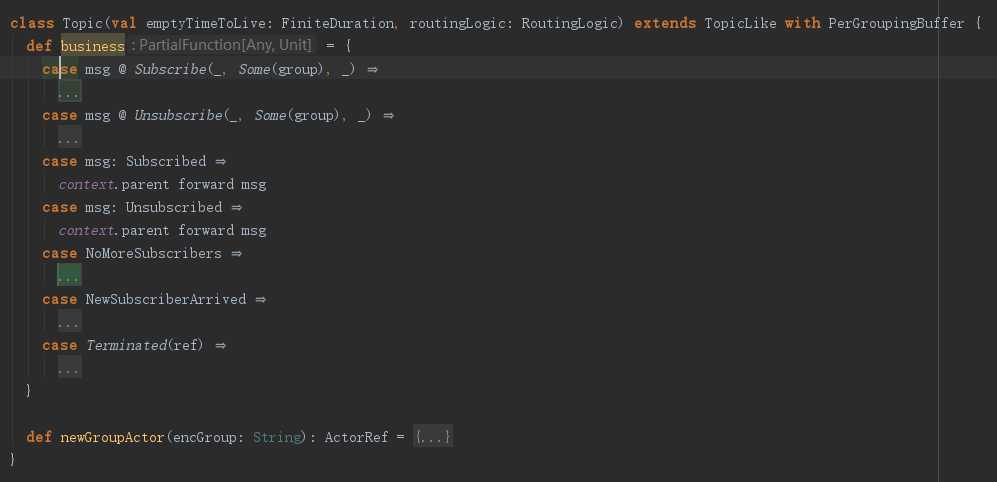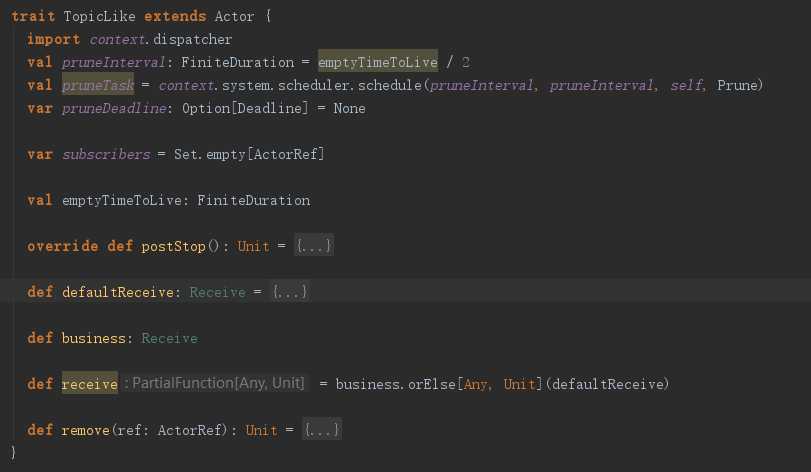Akka源码分析-Cluster-Distributed Publish Subscribe in Cluster
Posted gabry
tags:
篇首语:本文由小常识网(cha138.com)小编为大家整理,主要介绍了Akka源码分析-Cluster-Distributed Publish Subscribe in Cluster相关的知识,希望对你有一定的参考价值。
在ClusterClient源码分析中,我们知道,他是依托于“Distributed Publish Subscribe in Cluster”来实现消息的转发的,那本文就来分析一下Pub/Sub是如何实现的。
还记得之前分析Cluster源码的文章吗?其实Cluster只是把集群内各个节点的信息通过gossip协议公布出来,并把节点的信息分发出来。但各个actor的地址还是需要开发者自行获取或设计的,比如我要跟worker通信,那就需要知道这个actor在哪个节点,通过actorPath或actorRef通信。
“Distributed Publish Subscribe”就是用来屏蔽Actor位置的一个组件,通过它你可以给actor发消息而不需要知道actor的网咯位置。其实就是提供了一个类似kafka的消息发布、订阅的机制,其实吧,如果这个功能让你实现,你准备怎么做?肯定是在集群层面提供一个proxy,来屏蔽目标actor的网络位置啊。简单来说,就是提供一个通用的actor,来对消息进行转发,发送者只需要提供目标actor的路径就好了(比如/user/serviceA)。不过还是那句话,akka的都是对的,akka的都是好的。akka帮你实现这个事儿,就不用你自己考虑通用、稳定的问题啦。
消息订阅发布模式提供了一个中继actor:akka.cluster.pubsub.DistributedPubSubMediator。它管理actor的注册引用、分发实例引用给端actor,而且必须在所有的节点或一组节点内启动。它可以通过DistributedPubSub扩展启动,也可以像普通actor那样启动。
服务actor的注册是最终一致的,也就是说服务信息在变化时并不能立即通知给其他节点,过一段时间参会分发给所有节点。当然了每次都是以增量的信息分发这些信息。
消息的发送有两种模式:Send和Publish。简单来说就是点对点、广播。
Publish模式下,只有注册到命名的topic的actor才会收到消息,topic是啥?。其实这才是真正的订阅、发布模式。
class Subscriber extends Actor with ActorLogging {
import DistributedPubSubMediator.{ Subscribe, SubscribeAck }
val mediator = DistributedPubSub(context.system).mediator
// subscribe to the topic named "content"
mediator ! Subscribe("content", self)
def receive = {
case s: String ?
log.info("Got {}", s)
case SubscribeAck(Subscribe("content", None, `self`)) ?
log.info("subscribing")
}
}
class Publisher extends Actor {
import DistributedPubSubMediator.Publish
// activate the extension
val mediator = DistributedPubSub(context.system).mediator
def receive = {
case in: String ?
val out = in.toUpperCase
mediator ! Publish("content", out)
}
}
上面是官方的demo,可以看出,订阅者actor订阅了名为“content”的topic,在发布者actor发送指定topic的消息时,会自动收到对应的消息。怎么样,是不是很简单。其实吧,mediator只需要维护一个topic到订阅者的映射列表就好了,当收到对应topic的消息时,取出对应的订阅者(也就是ActorRef或actorSelection)把消息转发给他就好了。
Send模式就是一个点对点模式,每个消息被发送给一个目标,而不用知道这个目标actors的位置。既然之前我们说了,这是通过ActorPath发送的,那如果集群中同时有多个节点命中了这个ActorPath怎么办呢?那就路由呗,提供一个RoutingLogic 路由策略。默认策略是随机发送,当然了我们是可以修改这个策略的。与Publish模式不同,这里注册服务actor是通过Put消息实现的。不过实现原理都差不多,反正都要维护列表。
class Destination extends Actor with ActorLogging {
import DistributedPubSubMediator.Put
val mediator = DistributedPubSub(context.system).mediator
// register to the path
mediator ! Put(self)
def receive = {
case s: String ?
log.info("Got {}", s)
}
}
class Sender extends Actor {
import DistributedPubSubMediator.Send
// activate the extension
val mediator = DistributedPubSub(context.system).mediator
def receive = {
case in: String ?
val out = in.toUpperCase
mediator ! Send(path = "/user/destination", msg = out, localAffinity = true)
}
}
当然了,我们还是可以通过SendToAll把消息发送给所有命中指定path的actor的。
这里需要注意的是,官方的订阅发布组件只能保证至少一次投递,想想都是这样的,哈哈。废话不多说了,上代码。
object DistributedPubSub extends ExtensionId[DistributedPubSub] with ExtensionIdProvider {
override def get(system: ActorSystem): DistributedPubSub = super.get(system)
override def lookup = DistributedPubSub
override def createExtension(system: ExtendedActorSystem): DistributedPubSub =
new DistributedPubSub(system)
}
很显然DistributedPubSub这个扩展也是可以通过配置直接实例化的,不需要我们自行写代码实例化。由于其源码非常简单就是定义并创建了mediator这个actor(DistributedPubSubMediator),下面直接转到DistributedPubSubMediator源码的分析。
/** * This actor manages a registry of actor references and replicates * the entries to peer actors among all cluster nodes or a group of nodes * tagged with a specific role. * * The `DistributedPubSubMediator` actor is supposed to be started on all nodes, * or all nodes with specified role, in the cluster. The mediator can be * started with the [[DistributedPubSub]] extension or as an ordinary actor. * * Changes are only performed in the own part of the registry and those changes * are versioned. Deltas are disseminated in a scalable way to other nodes with * a gossip protocol. The registry is eventually consistent, i.e. changes are not * immediately visible at other nodes, but typically they will be fully replicated * to all other nodes after a few seconds. * * You can send messages via the mediator on any node to registered actors on * any other node. There is three modes of message delivery. * * You register actors to the local mediator with [[DistributedPubSubMediator.Put]] or * [[DistributedPubSubMediator.Subscribe]]. `Put` is used together with `Send` and * `SendToAll` message delivery modes. The `ActorRef` in `Put` must belong to the same * local actor system as the mediator. `Subscribe` is used together with `Publish`. * Actors are automatically removed from the registry when they are terminated, or you * can explicitly remove entries with [[DistributedPubSubMediator.Remove]] or * [[DistributedPubSubMediator.Unsubscribe]]. * * Successful `Subscribe` and `Unsubscribe` is acknowledged with * [[DistributedPubSubMediator.SubscribeAck]] and [[DistributedPubSubMediator.UnsubscribeAck]] * replies. * * Not intended for subclassing by user code. */ @DoNotInherit class DistributedPubSubMediator(settings: DistributedPubSubSettings) extends Actor with ActorLogging with PerGroupingBuffer
PerGroupingBuffer这个trait不再分析源码,从代码和命名来看,就是给每个group提供一个消息缓存的列表。其实这个actor最重要的功能是要能够感知集群节点的变化和对应服务actor的变化,并及时的把这些信息分发给其他DistributedPubSubMediator,还有就是能够把消息路由给指定的订阅者。为了简化分析,我们忽略第一个功能点,只分析是如何路由消息的。分析这点需要关注几个消息的处理逻辑:Put、Subscribe、Publish、Send、SendToAll。
先来看Subscribe 。
case msg @ Subscribe(topic, _, _) ?
// each topic is managed by a child actor with the same name as the topic
val encTopic = encName(topic)
bufferOr(mkKey(self.path / encTopic), msg, sender()) {
context.child(encTopic) match {
case Some(t) ? t forward msg
case None ? newTopicActor(encTopic) forward msg
}
}
Subscribe消息表明某个actor需要订阅某个topic的消息,简单来说就是先判断是否需要缓存,不需要的话就执行{}代码块。很显然,刚开始的时候是不需要缓存的。上面的逻辑就是从当前的children中查找encTopic的一个actor,然后把消息转发给它;不存在则创建之后再转发给它。那猜一下这个子actor的功能?其实吧,它应该是一个actor负责维护某个topic与所有订阅者的关系,所有发给这个topic的消息都会转发给所有的订阅者。
def newTopicActor(encTopic: String): ActorRef = {
val t = context.actorOf(Props(classOf[Topic], removedTimeToLive, routingLogic), name = encTopic)
registerTopic(t)
t
}
很显然newTopicActor创建了Topic这个actor,名字就是topic的值,并传入了两个参数:removedTimeToLive、routingLogic。第二个是路由策略。
def registerTopic(ref: ActorRef): Unit = {
put(mkKey(ref), Some(ref))
context.watch(ref)
}
put这个函数的功能我们先略过,其功能大概是把这个actor注册到系统内,把它与当前地址、版本号做关联并保存,在适当的时机分发出去。

Topic这个actor只有两个方法,所以还需要去看下TopicLike的代码。

可以看到TopicLike中有一个subscribers列表,这也是预期之中的。这个actor的消息会被business和defaultReceive处理,business在Topic中重新实现了,且会优先处理。
case msg @ Subscribe(_, Some(group), _) ?
val encGroup = encName(group)
bufferOr(mkKey(self.path / encGroup), msg, sender()) {
context.child(encGroup) match {
case Some(g) ? g forward msg
case None ? newGroupActor(encGroup) forward msg
}
}
pruneDeadline = None
收到Subscribe消息后,做了跟DistributedPubSubMediator类似的逻辑,又创建了一个子actor(Group),并把消息转发给了它。其实这一点在官方也有说过,也就是说,topic也是可以分组的,一个消息并不一定会发给所有订阅者,可以发给一组订阅者,其实吧,这一点我不太喜欢,感觉功能有点过了,如果要对topic划分子topic,用户自定义实现好了啊,搞得现在源码这么复杂。
class Group(val emptyTimeToLive: FiniteDuration, routingLogic: RoutingLogic) extends TopicLike {
def business = {
case SendToOneSubscriber(msg) ?
if (subscribers.nonEmpty)
Router(routingLogic, (subscribers map ActorRefRoutee).toVector).route(wrapIfNeeded(msg), sender())
}
}
Group的代码还这么简单,它又把Subscribe发给了TopicLike的defaultReceive
def defaultReceive: Receive = {
case msg @ Subscribe(_, _, ref) ?
context watch ref
subscribers += ref
pruneDeadline = None
context.parent ! Subscribed(SubscribeAck(msg), sender())
上面是defaultReceive对Subscribe消息的处理,就是watch,然后把订阅者添加到subscribers列表中,再告诉父actor(就是Topic这个actor)订阅成功了。
聪明的读者可能会问了,为啥topic还需要弄个消息缓存呢?其实吧,如果是我实现,肯定不搞这么麻烦啊。消息丢了就丢了啊,没有订阅者的时候,消息缓存起来等有订阅者的时候再发送出去?哈哈,有点浪费内存啊。不过为了稳定性、功能性、完善性,akka还是做了很多额外努力的。不过吧,建议还是把这个队列的大小调小一点,要不然太浪费内存了。不过很不幸的告诉你,目前没有这个开关。
既然订阅topic的逻辑跟我们的猜测差不多,那么发布消息的逻辑就应该也符合我们的猜测喽。其实就是获取某个topic对应的订阅者,然后foreach把消息发出去。
case Publish(topic, msg, sendOneMessageToEachGroup) ?
if (sendOneMessageToEachGroup)
publishToEachGroup(mkKey(self.path / encName(topic)), msg)
else
publish(mkKey(self.path / encName(topic)), msg)
简单起见,我们只分析消息不分组的情况
def publish(path: String, msg: Any, allButSelf: Boolean = false): Unit = {
val refs = for {
(address, bucket) ← registry
if !(allButSelf && address == selfAddress) // if we should skip sender() node and current address == self address => skip
valueHolder ← bucket.content.get(path)
ref ← valueHolder.ref
} yield ref
if (refs.isEmpty) ignoreOrSendToDeadLetters(msg)
else refs.foreach(_.forward(msg))
}
还记得registry什么时候赋值的嘛?如果忘了,可以翻翻registerTopic的代码,因为我没有分析,哈哈。不过不重要了,其实就是获取当前的Topic的Group的ActorRef,然后把消息转发给它。
case msg ?
subscribers foreach { _ forward msg }
Group继承的TopicLike中的defaultReceive方法处理了消息,其实就是把消息转发给所有的subscribers。
pub/sub的逻辑就分析到这里了,其实这里面的逻辑还是有点复杂的,当然了有一部分是因为topic分组带来的,其他的都是gossip协议分发订阅者、发布者的相关信息带来的。
下面分析Send模式。从Put消息的处理入手。
case Put(ref: ActorRef) ?
if (ref.path.address.hasGlobalScope)
log.warning("Registered actor must be local: [{}]", ref)
else {
put(mkKey(ref), Some(ref))
context.watch(ref)
}
这就有点简单了,就是把ref注册一下,然后watch。这个ref的key是ActorRef值,其实就是ActorPath.toString
case Send(path, msg, localAffinity) ?
val routees = registry(selfAddress).content.get(path) match {
case Some(valueHolder) if localAffinity ?
(for {
routee ← valueHolder.routee
} yield routee).toVector
case _ ?
(for {
(_, bucket) ← registry
valueHolder ← bucket.content.get(path)
routee ← valueHolder.routee
} yield routee).toVector
}
if (routees.isEmpty) ignoreOrSendToDeadLetters(msg)
else Router(routingLogic, routees).route(wrapIfNeeded(msg), sender())
其实就是从registry中优先找当前节点的订阅者,然后通过Router和指定的策略把消息发送出去,这个比pub/sub模式稍微简单点。wrapIfNeeded的功能不再分析,其实就是为了防止与用户本身的路由消息发生冲突。
关于节点信息同步,感兴趣的读者可以自行阅读源码,不过我看下来还是有几个问题的。比如当前注册信息的版本是通过时间戳来标志的,如果节点间时间不同步,会发生意外的结果啊;另外所谓的gossip协议,其实就是随机把注册信息发送给其他节点,也就是说集群内的节点都会把消息按照心跳时间,把注册信息随机发送给本身节点以外的节点,达到最终注册信息的同步。如果是我来实现,直接就是粗暴的广播注册信息,哈哈,不过这在集群规模比较大的时候比较耗时,啊哈哈。
以上是关于Akka源码分析-Cluster-Distributed Publish Subscribe in Cluster的主要内容,如果未能解决你的问题,请参考以下文章